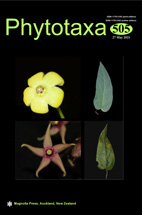Abstract
A new species of Inga (Leguminosae, Caesalpinioideae, Mimosoid clade), restricted to the Atlantic Forest of Minas Gerais State, Brazil, is described, illustrated, and compared in an inedited identification key to the species with stipitate extrafloral nectaries in the biome, Inga ciatiformis is similar to Inga cabelo and Inga platyptera. It differs from I. cabelo by having appressed-sericeous young branches, leaves with 1–3 pairs of leaflets, a terminal appendix 7–12 mm long, cyathiform extrafloral nectaries, bracts 9–13 mm long, linear, persistent, and a sparsely sericeous calyx (vs. hirsute-hispid young branches, leaves with 2–5 leaflets pairs, terminal appendix 2.5 mm long, capitate extrafloral nectaries, bracts 2 mm long, triangular, caducous, and a hirsute calyx). It differs from I. platyptera by having appressed-sericeous young branches, a cylindrical petiole and rachis, rachis rarely winged in the superior portion of the apical pair of leaflets, extrafloral nectaries always cyathiform, and linear bracts (vs. hispid young branches, winged petioles and rachises, extrafloral nectaries generally cupuliform, and lanceolate to ovate bracts).

